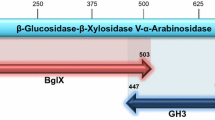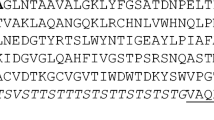Abstract
A full-length cDNA sequence, encoding a novel endo-1,4-β-d-xylanase (AuXyn10A) of Aspergillus usamii, was obtained by using rapid amplification of cDNA ends (RACE) methods and cloned into the pUCm-T vector, followed by DNA sequencing. The cDNA gene, designated as Auxyn10A, is 1,235 bp in length harboring 5′- and 3′-non-encoding regions, as well as an ORF of 984 bp that encodes a 19-aa signal peptide, a 6-aa propeptide and a 302-aa mature peptide with a calculated MW of 32,756 Da. The AuXyn10A displays high similarity to the xylanases of Aspergillus niger, Aspergillus kawachii and Aspergillus niger, members of the glycoside hydrolase family 10. Its three-dimensional structure was predicted using http://swiss-model.expasy.org/on-line programs based on the crystal structure of Penicillium simplicissimum xylanase (1B30_A) from the family 10. The complete DNA gene was cloned from the genomic DNA of A. usamii using conventional PCR and hairpin structure-mediated PCR techniques. The DNA gene is 2,255 bp in length, containing a 510 bp of 5′-flanking promoter region and a 1,745 bp of downstream fragment that consists of ten exons and nine short introns ranging from 52 to 62 bp.






Similar content being viewed by others
References
Biely P, Vršanská M, Tenkanen M et al (1997) Endo-β-1,4-xylanase families: differences in catalytic properties. J Biotechnol 57:151–166
Chantasingh D, Pootanakit K, Champreda V et al (2006) Cloning, expression, and characterization of a xylanase 10 from Aspergillus terreus (BCC129) in Pichia pastoris. Protein Express Purif 46:143–149
Collins T, Gerday C, Feller G (2005) Xylanases, xylanase families and extremophilic xylanases. FEMS Microbiol Rev 29:3–23
Deng P, Li DF, Cao YH et al (2006) Cloning of a gene encoding an acidophilic endo-β-1,4-xylanase obtained from Aspergillus niger CGMCC1067 and constitutive expression in Pichia pastoris. Enzyme Microb Technol 39:1096–1102
Fu DD, Xie H, Wu MC (2005) Solid fermentation for xylanase production by Aspergillus usamii. Food Ferment Ind 31:50–53
Huang JL, Wang GX, Xiao L (2006) Cloning, sequencing and expression of the xylanase gene from a Bacillus subtilis strain B10 in Escherichia coli. Biores Technol 97:802–808
Khandeparker R, Numan MTh (2008) Bifunctional xylanases and their potential use in biotechnology. J Ind Microbiol Biotechnol 35:635–644
Lampidonis AD, Stravopodis DJ, Voutsinas GE et al (2008) Cloning and functional characterization of the 5′ regulatory region of ovine hormone sensitive lipase (HSL) gene. Gene 427:65–79
Larson SB, Day J, Barba de la Rosa AP et al (2003) First crystallographic structure of a xylanase from glycoside hydrolase family 5: implications for catalysis. Biochemistry 42:8411–8422
Pastor FIJ, Gallardo O, Sanz-Aparicio J et al (2007) Xylanases: molecular properties and applications. In: Polaina J, MacCabe AP (eds) Industrial enzymes. Springer, Germany, pp 65–82
Polizeli MLTM, Rizzatti ACS, Monti R (2005) Xylanases from fungi: properties and industrial applications. Appl Microbiol Biotechnol 67:577–591
Rakhee K, Narayan BB (2007) Application of thermoalkalophilic xylanase from Arthrobacter sp. MTCC 5214 in biobleaching of kraft pulp. Biores technol 98:897–903
Reed DS, Gibson JB (1994) Molecular heterogeneity of naturally occurring sn-glycerol-3-phosphate dehydrogenase low-activity variants in Drosophila melanogaster. Biochem Genet 32:161–179
Sayari A, Frikha F, Miled N et al (2005) N-Terminal peptide of Rhizopus oryzae lipase is important for its catalytic properties. FEBS Lett 579:976–982
Subramaniyan S, Prema P (2002) Biotechnology of microbial xylanases: enzymology, molecular biology and application. Crit Rev Biotechnol 22:33–46
Wakiyama M, Tanaka H, Yoshihara K et al (2008) Purification and properties of family-10 endo-1,4-β-xylanase from Penicillium citrinum and structural organization of encoding gene. J Biosci Bioeng 105:367–374
Wang JS, Bai YG, Yang PL et al (2010) A new xylanase from thermoalkaline Anoxybacillus sp. E2 with high activity and stability over a broad pH range. World J Microbiol Biotechnol 26:917–924
Wendland J, Lengeler KB, Kothe E (1996) An instant preparation method for mucleic acids of filamentous fungi. Fungal Genet Newslett 43:54–55
Wenkel S, Turck F, Singer K et al (2006) CONSTANS and the CCAAT box binding complex share a functionally important domain and interact to regulate flowering of Arabidopsis. Plant Cell 18:2971–2984
Wu MC, Fu DD, Zhu J et al (2005) Purification and some properties of two xylanases from Aspergillus usamii. J Food Sci Biotechnol 24:29–33
Wu MC, Wang JQ, Zhang HM et al (2010) Cloning and sequence analysis of an acidophilic xylanase (Xyn I) gene from Aspergillus usamii E001. World J Microbiol Biotechnol
Zhou CY, Wang YT, Wu MC et al (2009) Heterologous expression of xylanase II from Aspergillus usamii in Pichia pastoris. Food Technol Biotechnol 47:90–95
Acknowledgments
We are grateful to Prof. Weida Huang (Department of Biochemistry, School of Life Sciences, Fudan University) for providing technical assistance.
Author information
Authors and Affiliations
Corresponding author
Rights and permissions
About this article
Cite this article
Wang, J., Zhang, H., Wu, M. et al. Cloning and sequence analysis of a novel xylanase gene, Auxyn10A, from Aspergillus usamii . Biotechnol Lett 33, 1029–1038 (2011). https://doi.org/10.1007/s10529-011-0524-9
Received:
Accepted:
Published:
Issue Date:
DOI: https://doi.org/10.1007/s10529-011-0524-9




